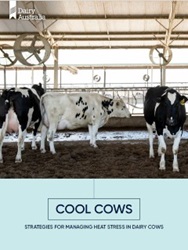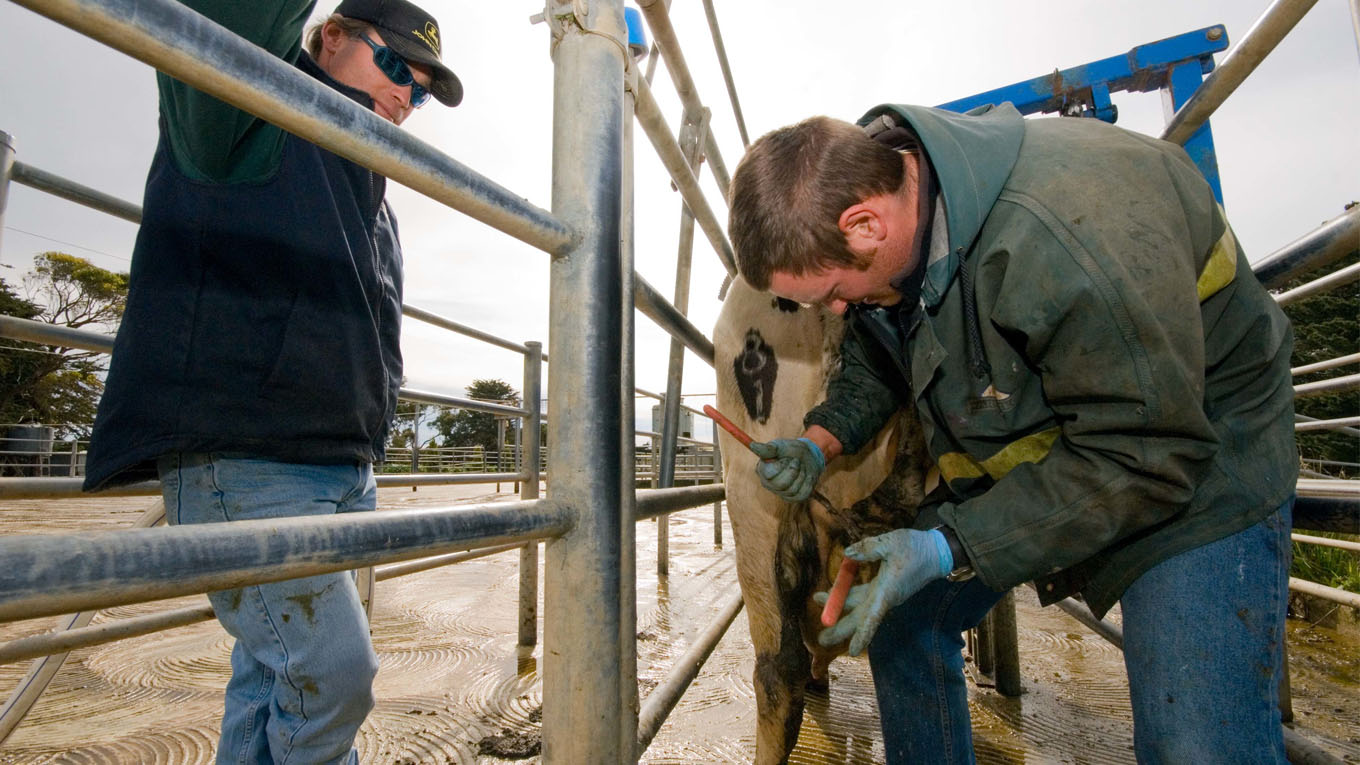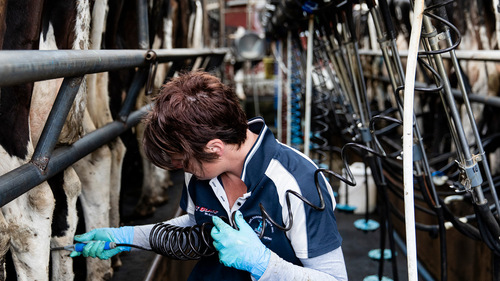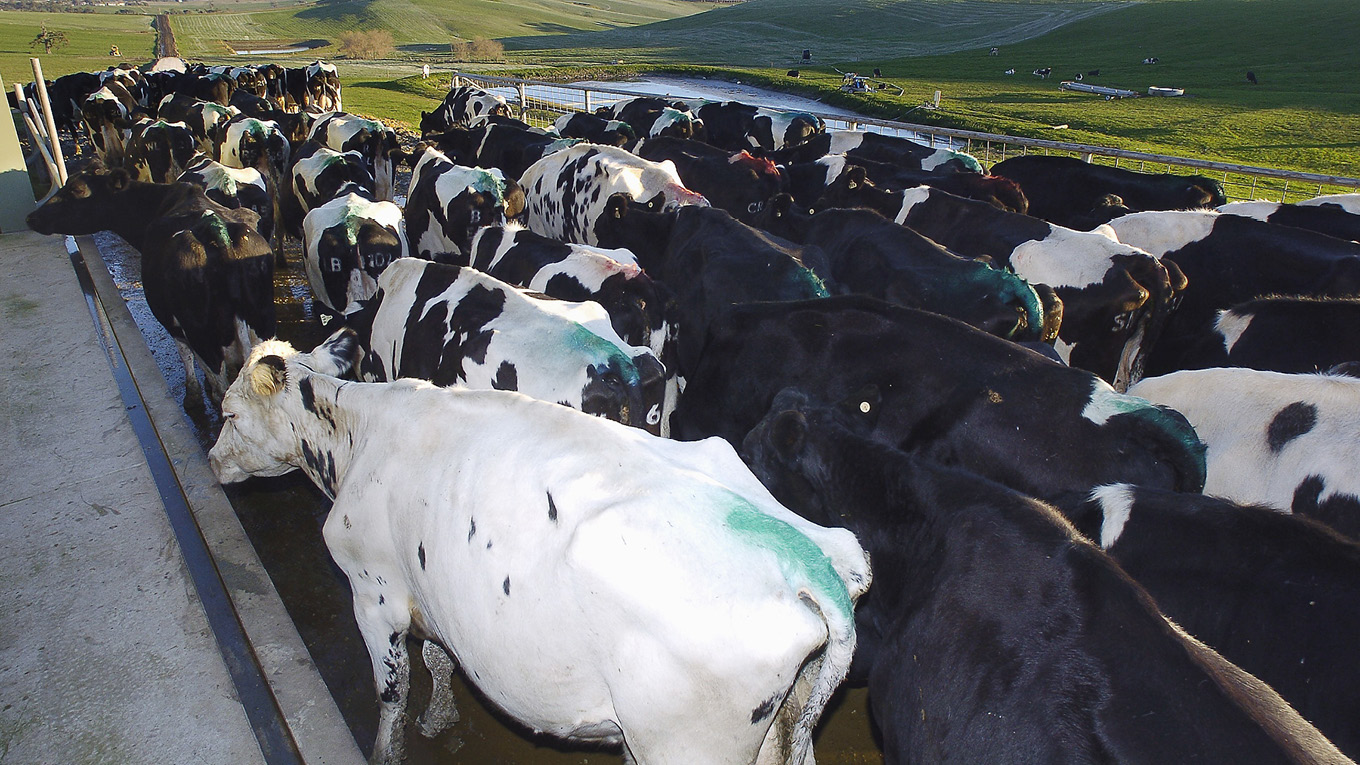Sprinklers
Sprinklers encourage heat loss through evaporative cooling and are an effective method of cooling a large number of cows quickly.
Dairy yard sprinklers assist cooling in a few different ways. Sprinkling cows before milking can lower breathing rates and increase milk yields. If cows are cool when leaving the dairy in the afternoon they will eat more overnight.
Sprinkled concrete loses heat via evaporation and conduction through contact with the cooler water. This reduces its ability to re-radiate heat to the cows standing on its surface. A small amount of heat is also off-loaded via conduction from hoof contact with the cooler concrete surface.
Sprinklers can also be used to wet cows so they can off-load heat via evaporation with the assistance of fans.
Fans are a useful complement to sprinklers, especially on days when there is little or no wind.
For more information on fans go to Fan System Design.
Dairy yard sprinklers
Sprinkler systems are relatively easy to install and can be built from irrigation or garden sprinklers and poly pipe.
Droplets must be medium large to allow water to penetrate the hair coat and wet the cow's skin.
Sprinklers should be spaced at intervals of 1.5 to 2.0 times their wetted radius so there is a slight overlap of wetted areas.
Piping must suit the length and area to be sprinkled, the number of sprinklers and their flow rate. Piping can be PVC or polythene and any exposed pipe should be painted white to keep water cool. The ideal water temperature is 15-20ºC.
-
Aim for medium-size droplets on a high-volume sprinkler to avoid a fine mist.
-
Cover the entire dairy yard so that all cows are wet in the first 10 minutes.
-
Conserve water by installing a timer and running sprinklers on an on/off cycle. For example sprinkle cow for 1-3 minutes every 15 minutes.
-
Don't pack cows too tightly as sufficient air movement is needed to allow evaporative cooling to work. Poor ventilation results in high humidity and health problems.
-
Position sprinklers along the sides of a dairy yard need to be mounted high enough to project water up and over cows, so it falls from above (ideally 2 m). This will minimise wetting of udders and the risk of mastitis. It will also prevent water being thrown directly into cows' ears.
-
Dry cows' teats if they get wet & allow time to dry, or dry them with a paper towel before putting cups on.
-
Avoid wetting cows immediately after milking to prevent teat disinfectant from being replaced with contaminated water while teat orifices are still open.
-
Pre-wet the dairy yard by hosing, flood washing or sprinkling for the hour before cows arrive for afternoon milking. This helps dissipate the heat stored in the concrete.
Spray curtains
Spray curtains are a relatively cheap cooling option that has the added benefit of keeping flies out of the dairy.
Spray curtains can be used in dairy yards but are normally attached to the underside of the dairy shed roof between the yard and the platform.
The example shown was constructed for less than $100 using 19 mm black polyethylene attached to the roof with garden sprinkler sprays inserted into the pipe every metre. It is about 2.5 m above the cows' feet level.
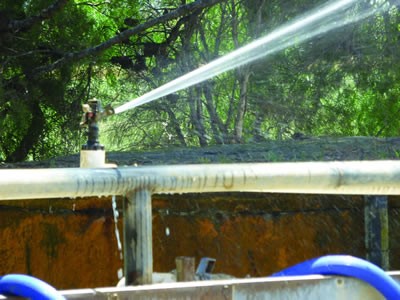
The sprinklers generate a semi-circle spray pattern that is directed towards the yard side of the shed.
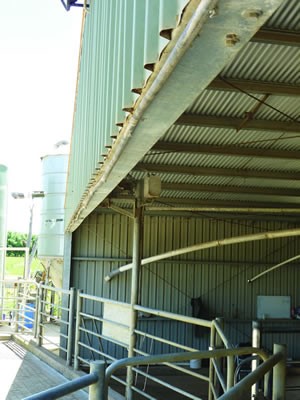
Spray curtain.
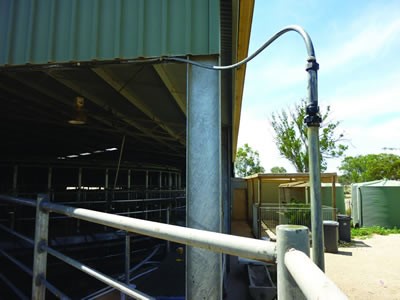
Spray curtain water supply and filter.
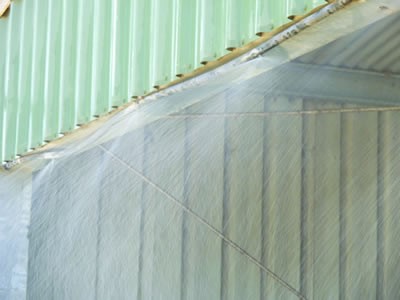
Spray curtain in operation.
Strengths
-
Low capital outlay.
-
Can be easily fitted to any dairy yard (or feedpad) with a concrete floor.
-
Effective method of cooling a large number of cows quickly.
Limitations
-
If droplet size is too small cooling will not be effective.
-
Use in high humidity conditions actually increases heat load on cows.
-
Without adequate air movement, cooling using sprinklers is not effective.
-
Need access to a reliable water supply.
The spray curtain not only keeps the dairy shed cool for cows and milkers, but it also reduces fly numbers in the dairy by washing flies off cows on entry and providing a wall of mist that prevents flies from entering the shed.
Remember that for evaporative cooling to be effective, the cows' skin needs to be wet, but not so wet that water dribbles down the udder.
Keys to success
-
Space out fans evenly to allow suitable airflow capacity for the area.
-
Orientate fans to work with the prevailing winds.
-
Mount fans above sprinklers.
-
Tilt fans down so they blow air between and underneath cows to enhance whole body cooling.
-
Operate on a temperature threshold to reduce unnecessary power use, and machine wear and tear.
![]()
Spray curtain in operation.
Design considerations for sprinkler systems
-
Sprinkler nozzles
Sprinklers can be effective in enhancing evaporative cooling. Their effectiveness will be lost when humidity is high and airflow is low.
Combined with good infrastructure to maintain airflow and using on-off timing to allow humidity to drop will maximise the effectiveness of sprinklers.
There are several sprinkler nozzle types that will adapt to your desired use, location, area and droplet size.
Type
Benefit
Limitation
Large irrigation sprinklers
Can wet a large area
High water use
Overhead wobbler sprinklers
Use less water
Do not throw water as far
Garden sprinklers
Use less water, also suitable for overhead use
Can be ineffective in windy conditions
Design tips
- Droplets must be medium-large to allow water to penetrate the hair coat and wet the cow's skin.
- Best position depends on type and capability of selected sprinkler and pumping system.
- However, as a guide, sprinklers should be spaced at intervals of 1.5 to 2 times their wetted radius, so there is a slight overlap of wetted areas.
- Sprinklers should be set at least 2 m above the floor of the dairy yard.
-
Pipes
Sizes must suit the length and area to be sprinkled, the number of sprinklers and their flow rates.
Shed length
Diameter of main delivery line
Up to 40 m
20 mm
40 - 60 m
25 mm
60 - 100 m
32 mm
More than 100 m
2 x 50m runs of 20mm
Design tips
- PVC piping does not twist, but polyethylene (PE) is cheaper.
- To maintain low water temperatures, all exposed pipe should be painted white and header tanks should also be shrouded, insulated and painted white.
- There are also some newly developed paints that have reflective properties that are worth investigation for their appropriateness for the chosen material.
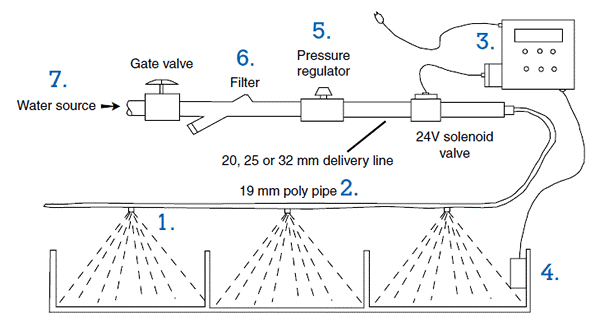
-
Ideal sprinkler system settings
Ideal State
Consideration
Water temperature
Temperature range: 15-20°C
Providing cows with chilled water at the dairy to help reduce heat load may reduce water intake and therefore be counter-productive.
Temperature sensors: Automatic
If an automated system is installed, ensure you can manually override it if necessary.
Water quality
Total dissolved solids (TDS): No more than 1000 mg/L TDS
High dissolved solids used in reticulation systems are corrosive and dissolve concrete.
Water output rate: 0.5-1 litre/head/hour
Excess water use will create waste management issues.
Note: For more complex or larger installations it is necessary to properly design the system taking into account friction losses, flow rates and component selection.
Pressure range
Low Pressure: 0.70 kg/cm2
Produces larger droplets, less mist and drift of spray.
Operating Pressure: 14 to 20 m (140-200 kPa).
A main pressure regulator can be installed at the beginning of the pipeline or smaller regulators on each sprinkler nozzle can be used.
Note: Large droplets penetrate the coat better. Smaller droplets can create an insulating layer of water on the cow's coat that can make the cow hotter instead of cooler droplets are required, not mist.
Filters and rates
Drip cooling system
Filter: 80 micron
Rate: 0.8 litres/secondSand or dirt may clog the sprinkler nozzles, so a filter is required between the water supply and solenoid valves that control the water flow to the spray nozzles or drip outlets.
Spray cooling system
Filter: 200 micron
Rate: 1.6litres/secondA common filter type is a plastic filter with a grooved disc filter element.
Usage advice on timers
A 15-minute adjustable type timer, attached to remote control valve (solenoid) will enable you to apply sufficient water on cows while minimising wastage.
Aim to sprinkle cows for 1-3 minutes, which should be sufficient to wet them effectively. Then shut off for the remainder of each 15-minute cycle to allow water to evaporate before the next cycle.
